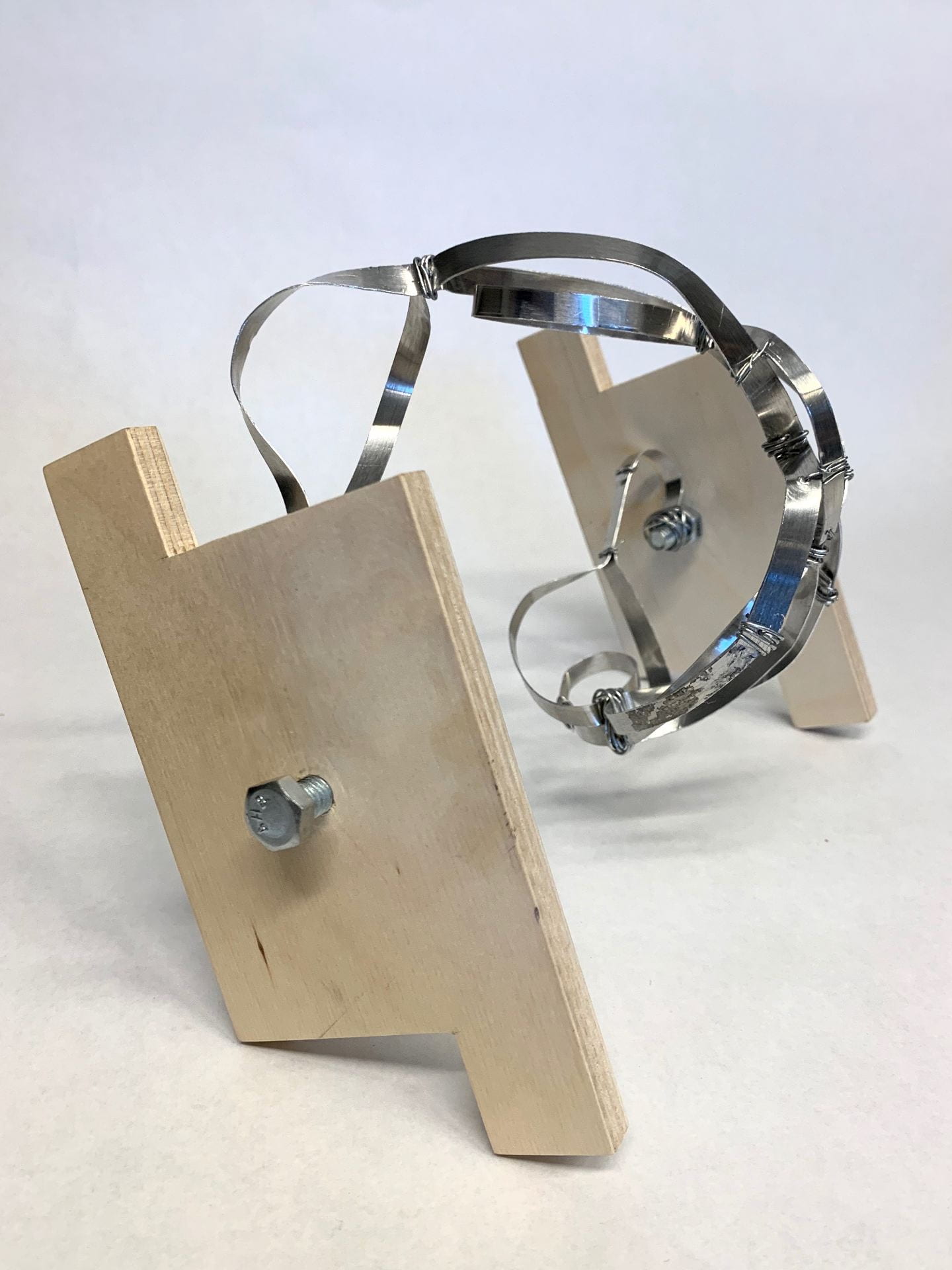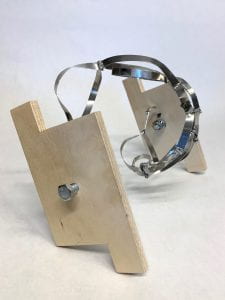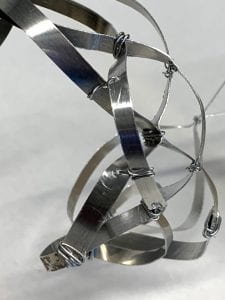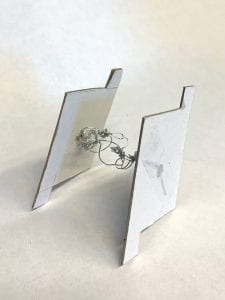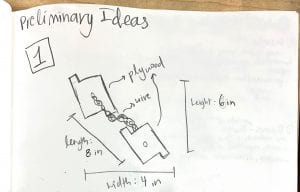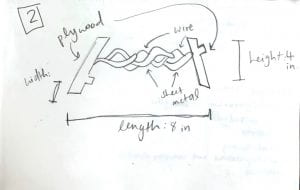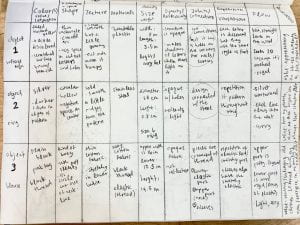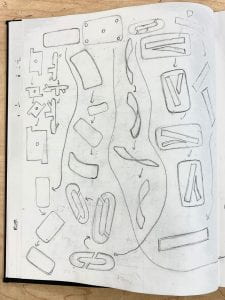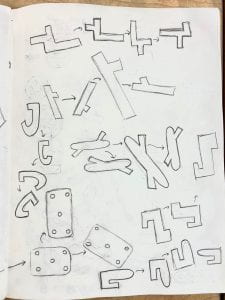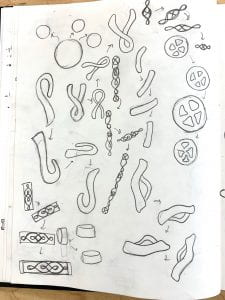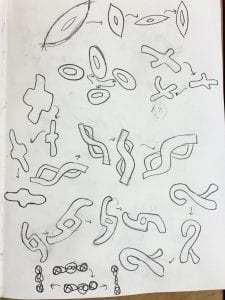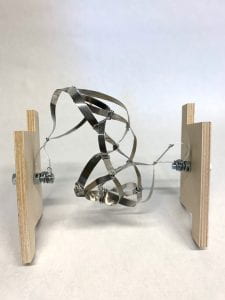
1. Describe your piece objectively, including the size, materials, and form. Be as accurate and specific as you can without explaining its meaning. Make sure to list your planar material, linear materials, and how you used plywood.
The piece is approximately 8 by 5 inches and the height is about 6 inches. For the planar materials, I used ¾ inch plywood and sheet metal and for the linear material, I used wire. The sculpture also features hex nuts and bolts in the connections. The sculpture is comprised of two pieces of wood that sit diagonally and connecting them is a loop of a couple strips of sheet metal. Each plywood piece is cut into a rectangular shape with two edges that protrude out of the top and bottom. The strips of sheet metal in between the plywood are bent into a curved design and is held up in the air.
2. How is your piece an artifact of your cultural identity? Discuss your inspiration for the piece: what objects did you work from and how do they inform your cultural identity? Which formal qualities of your object(s) did you combine to create an abstract sculptural artifact? (your images from your archive pages should illustrate these points*).
This piece is intended to represent two cultural objects that represent my values. The first one is a mustard-yellow voltage sign; it seems like such an insignificant object but this is exactly why it is so important to me. I was walking through a forest at a viewpoint in Santa Cruz and my friend Kai found it on the ground. As we were leaving, he gave it to me and told me to keep it in my dorm. It was a small gesture that made very happy because I also thought the sign itself had a really cool design. The meaning I find in this object is to always cherish the little things in life. I feel like people around me are constantly trying to strive for perfection in all aspects of their lives because they think it will make them happier, but they end up being unhappy because they are never satisfied with what they have. The voltage sign has a specific font that contains box letters; in between the L and T is the shape in my abstract sculpture that I cut out of the plywood. The second object I chose is a ring that was given to me by my mom a couple years ago. My mom immigrated from a small, poor village in Hyderabad, India to Monmouth University in New Jersey in 1986. The only way she was able to come to the U.S. was because she received a full scholarship for tuition and she would get free housing if she was an RA. My mom’s courage to move across the world where she knew nobody just so she could have a better life and provide for her parents back in India is something I will always be grateful for. She has taught me that everyone has the power to change their personal situation for the better and to never settle for something I am unhappy with. I am always reminded by her fearlessness, hard work, and persistence when I look down at my index finger. I chose to represent this object by manipulating strips of sheet metal to mimic the inner design of the ring. I specifically focused on the silver loops and the surrounding curves in the ring.
3. Explain how you chose the materials to make your sculpture, and what information they give the viewer about your culture.
Since the color of the voltage sign is yellow and faded, I thought plywood would be a good material to represent it with. The straight lines in the plywood represent how strongly I believe in my values. I chose to represent the ring with sheet metal because of the similarities in physical properties such as color and texture. The curved loop of strips of sheet metal represent how although I like to take time and enjoy life, I still like structure and am typically stubborn when it comes to my beliefs.
4. Describe the processes, skills, techniques, tools, and correctly list the joints/connections you used to make your project.
To cut the two pieces of plywood out, I used the bandsaw in the making center and made many straight line cuts. I used the sheet metal machine to cut thin strips that I measured out before. I then took the strips of sheet metal and began to bend them into loops and curves to create the pattern in my ring. To connect the different pieces of sheet metal together, I poked holes in multiple places in each sheet metal strip with an Ola knife and used wire to bind them together. After the strips were all connected into the design, I used my hands to bend the whole sheet metal structure into a loop. To connect the sheet metal to the plywood, I drilled holes in the plywood and screwed in hex bolts and nuts, then bound the two ends of the sheet metal structure to the two bolts with wire.
5. Explain how your sculptural artifact uses planes and lines to do each of the following 3 things: divide space, define space, and engage space,. Address both substance and negative space in your design. Include concepts and vocabulary introduced in class (see project sheet and reading).
The pieces of plywood sit diagonally to imply upward and outward movement. Because they rest on a diagonal edge, there is negative space under each piece of plywood. The piece also engages space through the sheet metal design that is hoisted up in the air and curved into a loop. The metal structure creates volume in the center and gives the sculpture a dynamic feel. Both materials I used could be viewed as a plane or a line. In some angles, the pieces of plywood look like straight lines due to its thin nature. The sheet metal is flat but since I cut it into thin strips it also looks linear. The sheet metal design in the center creates active energy in the middle of the sculpture and implies horizontal circular movement, which contrasts with the straight lines and upward diagonal movement that the plywood gives.
6. How did your understanding of 3D space evolve through the planning and making of this project? Describe the evolution of your project from prototype to finished sculpture.Include concepts and vocabulary introduced in class (see project sheet and reading).
My understanding of 3D space has evolved in many ways throughout the project. At first when I started sketching, I was mostly designing shapes that would sit one a flat side and ones that had cut outs similar to the voltage sign. I decided to choose a more simple shape and use two of the same one in my sculpture. I chose to represent the ring in a more intricate pattern instead of simpler shapes that were in my first sketches. My prototype was almost exactly similar to my sculpture, except I decided to use sheet metal to represent the wire in my prototype because I thought it would challenge me since I have already worked with wire. I also thought that using strips of sheet metal would be more interesting to look at and would define space and volume better. During the process of creating my sculpture, I thought a lot about orientation of the plywood pieces as well as the circular metal structure. I played around with the materials and found the orientation I believed to be most engaging and dynamic. One of my goals was to show contrast between the form and materiality of the two structures (plywood pieces and sheet metal) yet still depict them in harmony together to give the sculpture a good balance and flow.
7. Discuss the context of your work: write about how your project relates to the work of 2 of the artists we discussed in class during the reading discussion, the critique, or other class conversations. Hint: there is a list of artists on your project sheet that have been mentioned in class.
My work is based on cultural values that I resonate with and represents my beliefs and how I practice them. My sculpture’s form is similar to some of Naum Gabo’s artwork in the use of space and the materials he used. Gabo was associated with Russian Constructivism, which focused on art and functionality. One of his main beliefs is that empty space could be used as a sculptural element. The sheet metal structure that sits in between the plywood sculpture references this because it defines empty space and creates movement, something Gabo showed in his sculptures frequently. He also used a lot of kinetic movement in his work, and my sculpture has the ability to change its appearance by rotating the center piece. My work also relates to Carl Andre’s in the use of shapes made from plywood as planes. Andre’s use of blocks and geometric shapes is reflected in the two rectangular-shaped pieces of plywood in my abstract sculpture. He also aimed to reflect his ideas and beliefs through his sculptures and installations. My work implies horizontal movement and does not contain much height, which is similar to Andre’s work because it generally sits flat on the ground and gives the viewer in interesting experience when looking at it because it cannot be seen by looking straight ahead or upwards.
8. Reflect on one area where your craft is particularly strong and one thing that could be improved
One area of the piece I think is strong is the shape and form of the sheet metal strips. I like how I connected the strips together with small holes and thin wire and made the whole thing into a loop. I think the craftsmanship of the piece was overall good, but some of the connections could have been improved, particularly, the connections between the sheet metal structure and the plywood pieces on the hex bolts. I wish I had been more meticulous when I looped the wire around the bolts and sheet metal so it would look cleaner and hold together more stably.
